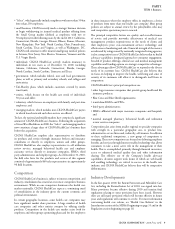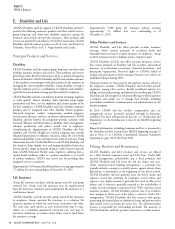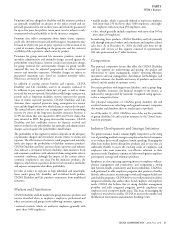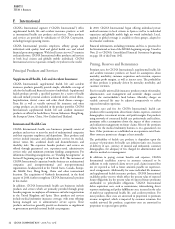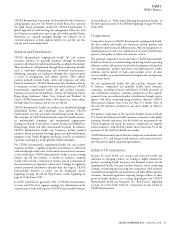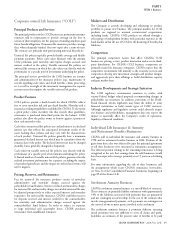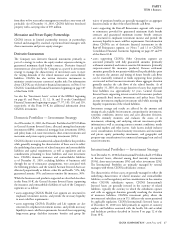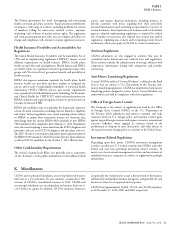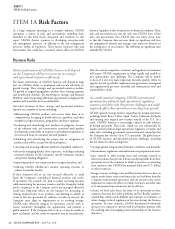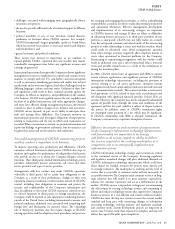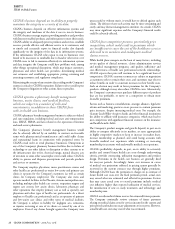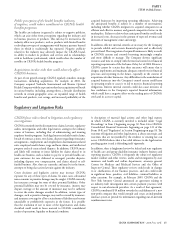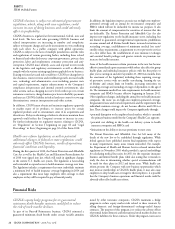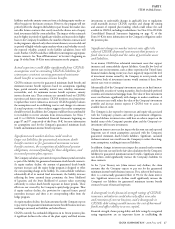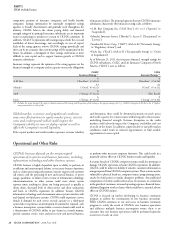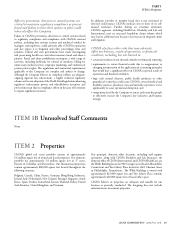Cigna 2010 Annual Report Download - page 39
Download and view the complete annual report
Please find page 39 of the 2010 Cigna annual report below. You can navigate through the pages in the report by either clicking on the pages listed below, or by using the keyword search tool below to find specific information within the annual report.CIGNA CORPORATION 2010 Form 10K 19
PARTI
ITEM 1 Business
e Patient Protection and Aff ordable Care Act left many of the
details of the new law to be established through regulations. While
federal agencies have published interim fi nal regulations with respect
to many requirements, many issues remain unresolved. For example,
the Department of Health and Human Services released interim fi nal
regulations in November 2010 which provided a special methodology
for calculating medical loss ratios for 2011 for expatriate insurance
business and limited benefi t plans while also stating that it intends
to study the data in determining whether special accommodations
will be made for these plans in 2012 and future years. In addition
to acting to comply with applicable requirements of the legislation,
CIGNA is closely monitoring regulatory developments and keeping
its clients apprised of changes that may aff ect them. (See further
Health Care reform discussion beginning on page 35.)
In 2010, Congress also enacted the Dodd-Frank Wall-Street Reform
and Consumer Protection Act which provides for a number of reforms
and regulations in the corporate governance, fi nancial reporting and
disclosure, investments, tax and enforcement areas that will aff ect
CIGNA. e full impact of this legislation may not be known for
several years until regulations become fully eff ective. CIGNA is
closely monitoring how these regulations will impact the Company.
Regulation of Insurance Companies
Financial Reporting
Regulators closely monitor the fi nancial condition of licensed
insurance companies and HMOs. States regulate the form and
content of statutory fi nancial statements, the type and concentration
of permitted investments, and corporate governance over fi nancial
reporting. CIGNA’s insurance and HMO subsidiaries are required to
fi le periodic fi nancial reports and schedules with regulators in most of
the jurisdictions in which they do business as well as annual fi nancial
statements audited by independent certifi ed public accountants.
Certain insurance and HMO subsidiaries are required to fi le an
annual report of internal control over fi nancial reporting with
most jurisdictions in which they do business. Insurance and HMO
subsidiaries’ operations and accounts are subject to examination by
such agencies.
Guaranty Associations, Indemnity Funds, Risk Pools
and Administrative Funds
Most states and certain non-U.S. jurisdictions require insurance
companies to support guaranty associations or indemnity funds,
which are established to pay claims on behalf of insolvent insurance
companies. In the United States, these associations levy assessments
on member insurers licensed in a particular state to pay such claims.
Several states also require HMOs to participate in guaranty funds,
special risk pools and administrative funds. For additional information
about guaranty fund and other assessments, see Note 24 to CIGNA’s
Consolidated Financial Statements beginning on page 121 of this
Form 10-K.
Some states also require health insurers and HMOs to participate
in assigned risk plans, joint underwriting authorities, pools or other
residual market mechanisms to cover risks not acceptable under
normal underwriting standards.
Solvency and Capital Requirements
Many states have adopted some form of the National Association of
Insurance Commissioners (“NAIC”) model solvency-related laws and
risk-based capital rules (“RBC rules”) for life and health insurance
companies. e RBC rules recommend a minimum level of capital
depending on the types and quality of investments held, the types of
business written and the types of liabilities incurred. If the ratio of the
insurer’s adjusted surplus to its risk-based capital falls below statutory
required minimums, the insurer could be subject to regulatory actions
ranging from increased scrutiny to conservatorship.
In addition, various non-U.S. jurisdictions prescribe minimum
surplus requirements that are based upon solvency, liquidity and
reserve coverage measures. During 2010, CIGNA’s HMOs and life
and health insurance subsidiaries, as well as non-U.S. insurance
subsidiaries, were compliant with applicable RBC and non-U.S.
surplus rules.
Eff ective December 31, 2009, the Company’s principal life insurance
subsidiary, Connecticut General Life Insurance Company (“CGLIC”),
implemented the NAIC’s Actuarial Guideline XLIII (also known as
AG 43 or VACARVM), which is applicable to CGLIC’s statutory
reserves for GMDB and GMIB contracts totaling $1.5 billion as
of December 31, 2010. As provided under this guidance, CGLIC
received approval from the State of Connecticut to grade-in the
full eff ect of the guideline over a 3-year period beginning in 2009.
At December 31, 2010, statutory reserves for CGLIC were higher
than the pre-AG 43 reserves by $123 million. If the guidance had
been fully implemented at December 31, 2010, statutory reserves
would have been higher by an additional $63 million. Management
does not anticipate that VACARVM will have a material impact
on the amount of dividends expected to be paid by CGLIC to the
parent company in 2011. In addition, VACARVM has no impact
on measurement of the Company’s results of operations or fi nancial
condition as determined under GAAP.
Holding Company Laws
CIGNA’s domestic insurance companies and certain of its HMOs
are subject to state laws regulating subsidiaries of insurance holding
companies. Under such laws, certain dividends, distributions and
other transactions between an insurance or HMO subsidiary and its
affi liates may require notifi cation to, or approval by, one or more state
insurance commissioners.
Marketing, Advertising and Products
In most states, CIGNA’s insurance companies and HMO subsidiaries
are required to certify compliance with applicable advertising
regulations on an annual basis. CIGNA’s insurance companies and
HMO subsidiaries are also required in most states to fi le and secure
regulatory approval of products prior to the marketing, advertising,
and sale of such products. State and/or federal regulatory scrutiny
of life and health insurance company and HMO marketing and
advertising practices, including the adequacy of disclosure regarding
products and their administration, may result in increased regulation.
Products off ering limited coverage, such as those CIGNA issues
through the Star HRG business acquired in July 2006, continue to
attract increased regulatory scrutiny.


